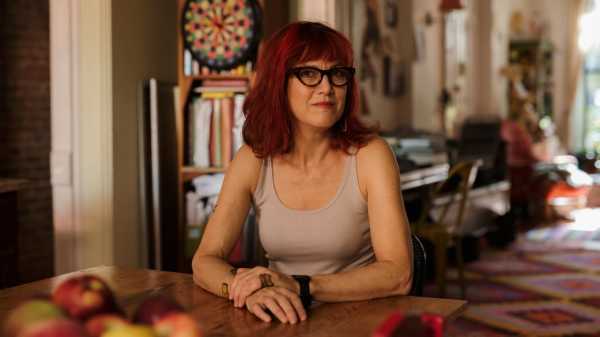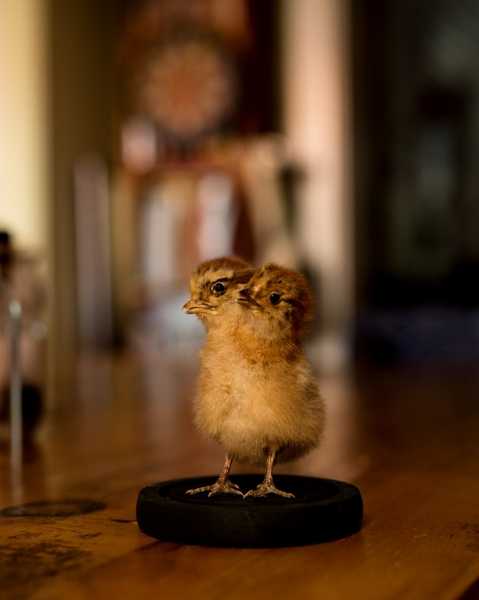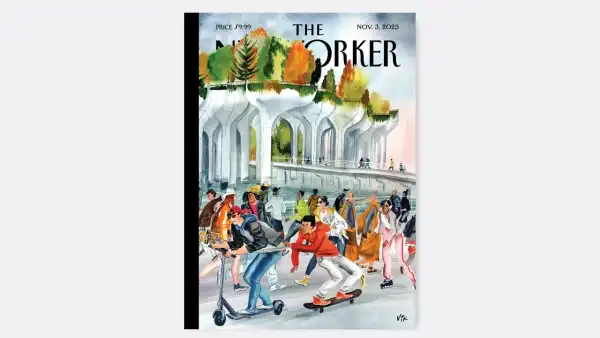
Just inside Shelley Jackson’s Brooklyn brownstone, a pastel-splotched creature several feet tall held out its plastic paws in an attitude of supplication, or welcome. Its huge eyes had a lysergic taint, like those of a feverish child. Jackson, the author of six physical books and three works of hypertext, as well as the progenitor of many hard-to-categorize literary experiments, is a self-declared lover of—and advocate for—the monstrous. Among the other treasures jostling for space inside her living room were a taxidermied two-headed chick, a tchotchke of conjoined twins, an ear trumpet from the eighteen-hundreds, and a ventriloquist’s dummy. “I like things that give me the creeps,” she told me. “That’s really where I start writing anything—when I have a reaction that is uneasy, squeamish in some way.” Jackson had found the giant pastel creature, a kangaroo, on the side of a street. She and I stood and considered it for a moment. “I think she’s a diaper holder,” Jackson said, lifting a grubby-looking plastic apron to reveal a cavity stuffed with plastic bags, which she uses on walks with her three-legged dog, Bailey.

Photograph by Valerie Chiang for The New Yorker
For Jackson, inanimate objects—like the bizarre marsupial—bear the suggestion of sentience and the strange promise of communication. She feels, she told me, as if “they’re kind of trying to tell you something, but, because they can’t fully articulate it, it stays suspended there.” Her new book, “Riddance; or, The Sybil Joines Vocational School for Ghost Speakers & Hearing-Mouth Children,” is a ravishing novel charged with the idea of the incommunicable. It’s set in a boarding school for stammerers, where a megalomaniacal headmistress named Sybil Joines trains her pupils to speak with the dead—an act of necromancy that requires, Joines claims, a complete erasure of self. The book takes place in 1919, when a flourishing of spiritualism coincided with the arrival of new communications technology. As Jackson has pointed out before, Thomas Edison believed that he might be able to get the dead on the phone.
What Jackson described as the contradiction of “trying to think in this modern and scientific way about things that are totally imaginary or spiritual” is the sort of intellectual paradox that drives her writing. “Riddance” is a Frankensteinian assemblage of fictional newspaper clippings, sheet music, eerie photographs, diagrams of speech exercises, and far-fetched curios, including a “speculative map of the necrocosmos.” But these messy—monstrous—materials are rigorously organized, grouped into alternating sections: “The Final Dispatch,” which consists of dictation from the land of the dead, via Headmistress Joines; “The Stenographer’s Story,” an account from Joines’s teen-age pupil and scribe, Jane Grandison; “Readings,” a miscellany of instructional materials and observations from visitors to the school; and “Letters to Dead Authors,” featuring a gothic lineup of addressees, among them Edgar Allan Poe and Emily Brontë. Included in “Readings” are excerpts from a fictitious manual called “Principles of Necrophysics,” about how to ventriloquize ghosts, which asserts, “To yield your mouth to the voice of another, you must suppress what you may be used to thinking of as ‘your own’ voice.” The instruction sounds as germane to writing fiction as it does to communicating with the dead. Jackson doesn’t see much of a distinction between the two.
Jackson, who is fifty-five, grew up in Berkeley, California. She was a shy child, and her shyness manifested not as a speech impediment, per se, but as a dread of talking. Specifically, she said, as we settled into her living room and the sky outside darkened, she had a fantasy of speechlessness. “This is so gruesome, but it was a pleasant fantasy—that I might have my tongue cut out,” she confessed. “That I would wear, like, a piece of slate hanging around my neck with a piece of chalk dangling from it so I could write down what I wanted to say.” She added, “There was something about the pace of speech and the self-consciousness that was induced in me by people’s attention that made it impossible for me to frame a thought, or even imagine how it could be done.” One of the problems, she said, was that her vocabulary wasn’t playground-appropriate. It was bookish, sesquipedalian. As the headmistress in “Riddance” says, recalling her girlhood, “My style was scarcely juvenile. If anything, it was senescent, with the gaseous orotundity of an earlier era.”
Eventually, Jackson learned to think of speaking “as a kind of writing out loud,” and so “this handicap turned into my advantage,” she explained. I thought of an excerpt from the “Principles of Necrophysics”: “It is hard to believe that stuttering and stammering were ever regarded as speech impediments.”

Photograph by Valerie Chiang for The New Yorker
Jackson was dressed in short shorts and a tank top that made visible several of her tattoos. An ampersand on her upper arm was acquired in her early twenties, when it served, she said, as a “declaration of fealty to the principle of plurality—not being willing to allow myself to be reduced to one identity or project, one art form.” In the decades since, she has made good on this declaration (and continues to sign off her e-mails with “&”). Jackson is perhaps best known for an ongoing project called “Skin,” in which the words of a short story are tattooed, one by one, on volunteers, who then, as Jackson sees it, themselves become the story’s words. More than ten thousand people have applied to take part in the project since it began, in 2003; Jackson has accepted 1,875 of them. As she writes on her Web site, the participants in “Skin” are not understood as carriers or agents of the texts they bear but as its embodiments: “Only the death of words effaces them from the text.” Many of the volunteers are total strangers to Jackson, yet she pledges that she “will make every effort to attend the funerals of her words.”
It is unsurprising that a writer so in thrall to the mystery and materiality of things should also be known as one of the pioneers of electronic literature. Jackson’s experiments include “The Doll Games” (2001), which catalogues the childhood improvisations of her and her sister Pamela, complete with a florid introduction by a fictitious academic, J. F. Bellwether. “Patchwork Girl” (1995) is a non-chronological, hyper-textual rengagement with Mary Shelley’s “Frankenstein,” in which readers chooses their own virtual circuits through the text by jumping between links. (It is available to purchase in the corporeal form of a CD or USB drive.) Like “Patchwork Girl,” “My Body: A Wunderkammer” (1997), is an electronic, disembodied text thematically preoccupied with the human form. In an essay in “The Bloomsbury Handbook of Electronic Literature,” from 2017, Jackson invited people to consider reading “Moby-Dick” on an iPhone:
We gain a sense of the sleekness of water, of the depths concealed
beneath its bright and changing surface, and above all its
reflectivity, so important to Melville that he positioned the story of
Narcissus in his first paragraph. (So it is not a simple matter of one
medium being better or worse, more evocative or less, than another.
Different matter, different meaning.)
We lose, on the other hand, all the weight of the whale. We lose the
feeling of dissecting its great mass, slice by slice. We lose our
tactile measure of our slow progress through it.
Hypertext flourished in the mid- to late nineties the Internet’s quixotic teen-hood. Now that the Internet has entered bilious middle age, the future-facing genre seems curiously dated. Jackson admitted that the potential of the Internet still intrigues her. “But its reality has become so overwhelming that it kind of nauseates me,” she said. She is not on Twitter; her Web site, called Ineradicable Stain, remains an ornery, playful cabinet of curiosities rather than the self-promotional placeholder expected of contemporary writers. There is no ingratiating “About Me” section, for example, but, instead, a page with the existential header “Who Is Is,” subtitled “self-pollution.” Her most recent online project is a meandering short story told in Instagram posts of words traced in snow: ephemerality made permanent in the ether of a social-media app.
“Riddance” took twelve years to write. Halfway through, Jackson and her partner adopted a daughter, Shibire, to whom the book is dedicated. Both parents are white, and Shibire is black. As Jackson continued grappling with her manuscript, she realized that she hadn’t thought nearly enough about race. There was something missing, she concluded, from the book’s metaphysics as promulgated by the headmistress, “an incredibly powerful, dominant and self-obsessed person who is ranting about having no self.”
“Perhaps the capacity to imagine that the self didn’t exist was a luxury that was only really available to people whose claim to existence hadn’t been challenged in the first place,” Jackson said, recounting her thought process. She added, “I think that the idea that there is such a thing as a neutral self is a white fantasy.” And so Jane, a black student at the school, came into focus. Despite, or perhaps because of, her privileged role as the headmistress’s amanuensis, Jane is one of the most vociferous voices of dissent against the practice of self-erasure in the name of necromancy. For her, the effacement of giving oneself over to ghosts is painfully mirrored in reality. “From time to time I was uneasy,” she says at one point in the book. “When I passed one of the colored maids, for instance, both of us hurrying, with things in our hands. At those times I apprehended that I was only by some frail magic walking on the water in which she was submersed, and feeling myself foundering, looked away.” Her erasure is threatened by the living, not the dead.
Later in the novel, the headmistress asks Jane whether she wants to find herself or to lose herself, “to go home, or to leave home forever?” The two, Jane realizes, are the same thing: “To run away from everything, even my own self, was to find a home I could never lose, because it was loss itself.” If selfhood is a fiction, it’s a powerful one, as much truthful consolation as outright lie. Jackson admitted that, like her characters, she wrestles with this same illusion. “On a certain level, I doubt my cohesion as a human being,” she said.
At the beginning of “Riddance,” Headmistress Joines writes a letter to Herman Melville, who has been dead for nearly thirty years. “Stuttering, like writing, is an amateur form of necromancy,” she asserts. In her living room, Jackson explained to me what she and the headmistress mean. “When you think about language in an expanded sense, it is, in fact, the case that we’re channelling the dead when we speak,” she said, adding that, whenever we talk, chances are “we’re echoing the words that people before us have said.” She didn’t mean something supernatural, exactly—more like a literary ghostliness. Through books, she said, readers are constantly communing with “the spirits of bygone people.” Language is an inherently spooky thing, and reading fiction can often feel like being possessed. “Most of my favorite writers are dead, which is kind of to say that most of my favorite people are dead,” Jackson said. “But that hasn’t stopped me from having a good conversation with them.”
Sourse: newyorker.com






